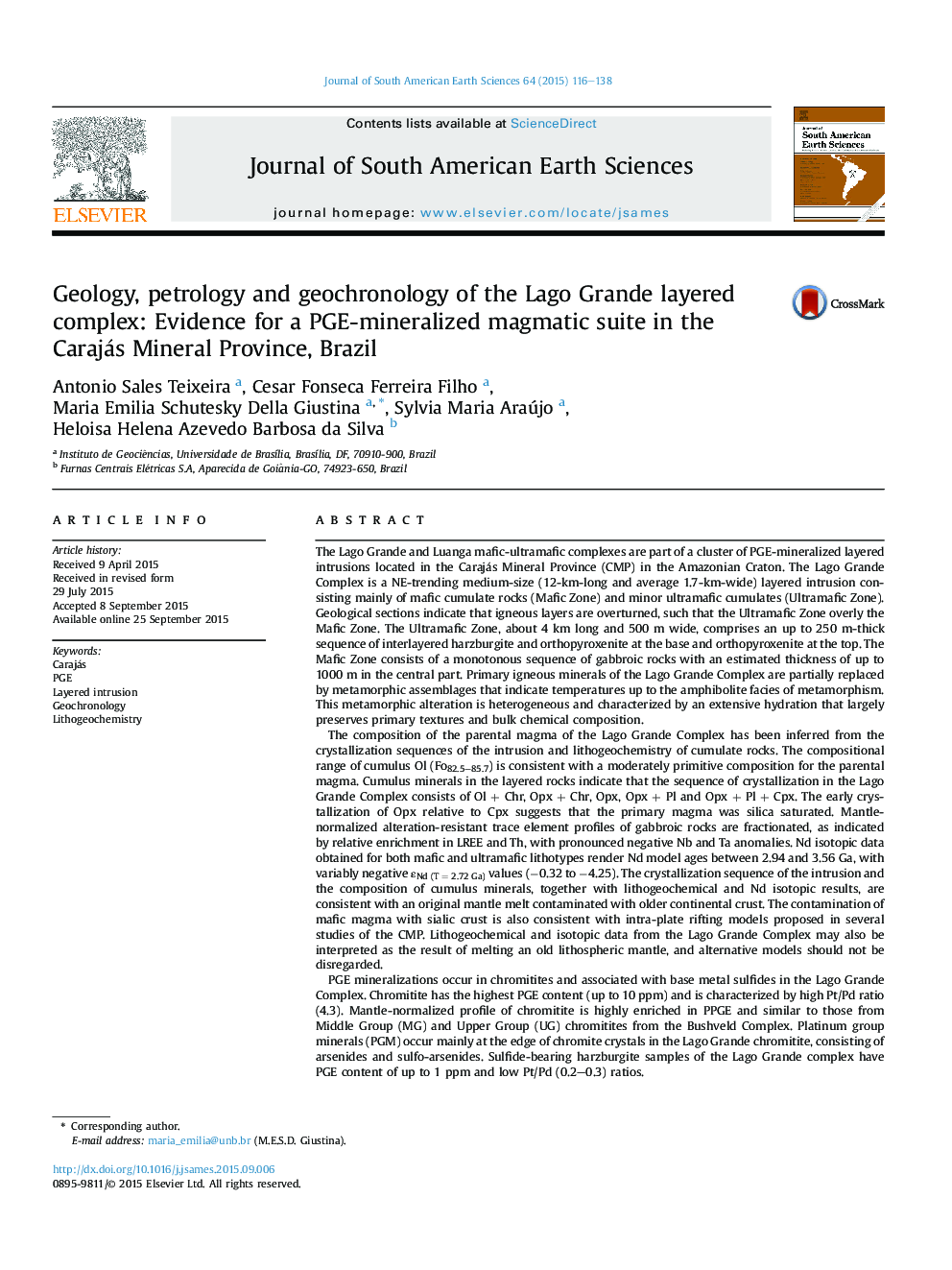| کد مقاله | کد نشریه | سال انتشار | مقاله انگلیسی | نسخه تمام متن |
|---|---|---|---|---|
| 4682113 | 1348894 | 2015 | 23 صفحه PDF | دانلود رایگان |

• The Lago Grande Complex is a PGE-mineralized layered intrusion.
• PGE mineralizations occur in chromitites and associated with base metal sulfides.
• U–Pb zircon crystallization age of the layered intrusion is 2722 ± 53 Ma.
• Metamorphic alteration is heterogeneous and characterized by an extensive hydration.
• 2.55 Ga zircon ages suggest the influence of the regional IOCG hydrothermal event.
The Lago Grande and Luanga mafic-ultramafic complexes are part of a cluster of PGE-mineralized layered intrusions located in the Carajás Mineral Province (CMP) in the Amazonian Craton. The Lago Grande Complex is a NE-trending medium-size (12-km-long and average 1.7-km-wide) layered intrusion consisting mainly of mafic cumulate rocks (Mafic Zone) and minor ultramafic cumulates (Ultramafic Zone). Geological sections indicate that igneous layers are overturned, such that the Ultramafic Zone overly the Mafic Zone. The Ultramafic Zone, about 4 km long and 500 m wide, comprises an up to 250 m-thick sequence of interlayered harzburgite and orthopyroxenite at the base and orthopyroxenite at the top. The Mafic Zone consists of a monotonous sequence of gabbroic rocks with an estimated thickness of up to 1000 m in the central part. Primary igneous minerals of the Lago Grande Complex are partially replaced by metamorphic assemblages that indicate temperatures up to the amphibolite facies of metamorphism. This metamorphic alteration is heterogeneous and characterized by an extensive hydration that largely preserves primary textures and bulk chemical composition.The composition of the parental magma of the Lago Grande Complex has been inferred from the crystallization sequences of the intrusion and lithogeochemistry of cumulate rocks. The compositional range of cumulus Ol (Fo82.5–85.7) is consistent with a moderately primitive composition for the parental magma. Cumulus minerals in the layered rocks indicate that the sequence of crystallization in the Lago Grande Complex consists of Ol + Chr, Opx + Chr, Opx, Opx + Pl and Opx + Pl + Cpx. The early crystallization of Opx relative to Cpx suggests that the primary magma was silica saturated. Mantle-normalized alteration-resistant trace element profiles of gabbroic rocks are fractionated, as indicated by relative enrichment in LREE and Th, with pronounced negative Nb and Ta anomalies. Nd isotopic data obtained for both mafic and ultramafic lithotypes render Nd model ages between 2.94 and 3.56 Ga, with variably negative εNd (T = 2.72 Ga) values (−0.32 to −4.25). The crystallization sequence of the intrusion and the composition of cumulus minerals, together with lithogeochemical and Nd isotopic results, are consistent with an original mantle melt contaminated with older continental crust. The contamination of mafic magma with sialic crust is also consistent with intra-plate rifting models proposed in several studies of the CMP. Lithogeochemical and isotopic data from the Lago Grande Complex may also be interpreted as the result of melting an old lithospheric mantle, and alternative models should not be disregarded.PGE mineralizations occur in chromitites and associated with base metal sulfides in the Lago Grande Complex. Chromitite has the highest PGE content (up to 10 ppm) and is characterized by high Pt/Pd ratio (4.3). Mantle-normalized profile of chromitite is highly enriched in PPGE and similar to those from Middle Group (MG) and Upper Group (UG) chromitites from the Bushveld Complex. Platinum group minerals (PGM) occur mainly at the edge of chromite crystals in the Lago Grande chromitite, consisting of arsenides and sulfo-arsenides. Sulfide-bearing harzburgite samples of the Lago Grande complex have PGE content of up to 1 ppm and low Pt/Pd (0.2–0.3) ratios.The 2722 ± 53 Ma U–Pb zircon age determined in this study for the Lago Grande Complex overlaps with the crystallization age of the Luanga Complex. Previous interpretation that the Lago Grande and Luanga layered intrusions are part of a magmatic suite (i.e., Serra Leste Magmatic Suite) is now reinforced by similar fractionation sequences, comparable petrological evolution and overlapped U–Pb zircon ages. The occurrence of the same styles of PGE mineralization in the Lago Grande and Luanga complexes, together with remarkably similar chondrite-normalized PGE profiles and PGE minerals for chromitites of both complexes, support the concept that they belong to the same PGE-fertile magmatic suite.U–Pb isotope analyses of zircon crystals obtained on bright luminescent rims with typical recrystallization features reveal a cluster of concordant to slightly discordant dates pointing at 2553 ± 61 Ma. These are likely to correspond to a significant disturbance of the U–Pb system of the Lago Grande Complex during the ca. 2.55 Ga regional scale hydrothermal event associated with the origin of IOCG type deposits. Common Bi–Cl minerals associated with highly transformed PGE-mineralized zones also suggest hydrothermal alteration by the regional IOCG type system. This type of alteration identified in the Lago Grande mafic-ultramafic layered intrusions may provide the explanation for common Ni–Co anomalies identified in several Cu–Au deposits, as well as hydrothermal Au–Pd mineralizations in Carajás.
Figure optionsDownload as PowerPoint slide
Journal: Journal of South American Earth Sciences - Volume 64, Part 1, December 2015, Pages 116–138